How to Dock and Undock a Boat
Like parallel parking a car, docking and undocking a boat just gives some people anxiety. But it doesn’t have to be that hard. You can prepare ahead of time and give yourself time to practice as well. Make a plan for docking and a plan for docking.
How to Dock a Boat
There are a few steps you’ll need to undertake to make this work like a charm. Once you have them mastered, it should be a pretty easy process for you in the future.
Get Your Spring Line, Bow Line and Stern Line Ready
Probably the most important thing before embarking on any docking or undocking is knowledge. If you have a crew on board, are they able to help? If so, do they know what they’re doing? If you’re just out your fishing boat with a buddy, does he have any boating experience? If not, and you need his help to dock or undock, you’ll need to make expectations clear. Never assume anyone has the same knowledge as you. A good idea is to give very clear directions ahead of time. Make sure they know what you’re talking about when you say fenders or spring lines. Check to see if they’re comfortable using a boat hook. Then you can begin.
Start by making sure you have one end of your docking lines secured on board. Have your fenders at the ready as well. You’ll probably want at least three fenders. Keep them above the water line, they shouldn’t be getting wet. And you’ll want to have a bow line, a stern line, and a spring line ready.
The Approach
Now you can reduce speed as you prepare to approach the dock. You should have your plan of action in mind at around 100 yards out from where you plan to dock. This is especially important if you’re heading into a busy marina.
Throttle back to a slow speed on approach. Make sure your crew knows their duties if it’s applicable here. Your first mate should know to secure those lines or attach the fenders. Keep an eye out for traffic. If no one else is around, docking or undocking, you may have more time and latitude with your approach. However, if the marina is busy then you may need to change your plans slightly. This could mean being faster or slower, maybe waiting for others or being more cautious.
Onshore Wind Approach
You need to work with how the wind blows when you’re docking. With an onshore wind the wind is blowing towards the dock. The current can affect your boat handling and may work against the wind. If so, then you’ll be moving more slowly. If the current is with the wind, then that will help push you.
In general, a longer approach is always better. More time to make adjustments, more time to see what you’re doing and plan ahead.
When you’re about 20 yards out, put the boat in neutral. Any adjustments you make from here on out need to be very and precise. Control speed to control the docking. You don’t want to have your motor in gear for more than two seconds at a time as you fine tune your approach. Keep your RPMs below 900. This will ensure you have a reasonable amount of control over the boat. Too much more and you risk losing control and hitting the dock or missing your mark. Too much less and you won’t have the control you need.
You can bring your boat in parallel to the dock with the wind behind you. Just line up about two feet off of the dock. Make short burst adjustments with your engine to get in position. The wind will do the rest of the work for you. Forward and reverse at low throttle in quick bursts to make fine adjustments. Once you’re in position to motor forward a little and use your dock lines do so. Secure your bow lines, stern lines and spring lines and you’re good to go.
Offshore Wind Approach
With an offshore wind, the wind is blowing away from the dock. That means it’s pushing you away, so you need to adjust for that. Approach the dock at somewhere between a 20 degree and 30 degree angle. Use the same idea with short engine bursts to help get you lined up while compensating for the wind.
If you have an outboard or an inboard/outboard you’ll want to get it turned towards the dock, then try to ease in reverse. This will angle your stern towards the dock, and you can get a line secured.

This will keep you from going too far forward. Having the engine idling forward and then turning the wheel away from the dock. The forward spring line stops you from moving forward and the rudder will bring you in line with the dock. Then you can finish securing your lines. If you have twin engines, this can be done even more easily.
A dock hand can secure your bowline. If it’s a deckhand helping, make sure they know not to act like King Kong with it. They don’t need to pull it with all their force. The bowline should not be jerking the stern around.
Multi-Engine Docking
If you have more than one engine on your boat, you’ll need to tweak your docking approach very slightly. Most of your preparation will be the same. However, as you’re approaching those final few meters, you’ll need to make small changes. In this case, you’ll want to leave the wheel in a central position. You’re going to want to use the outermost engines to do your maneuvering towards the dock. So if you have two engines, one and two will be used to maneuver. If you have 3, just one and three with two remaining off. And if you have four, you’ll use one and four while two and three stay off.
If you’re backing down with twin screws, use the starboard engine. Cut the wheel hard to port and you’ll see the boat start to fall into line smoothly.
Moving the shifters of your outermost engines only will allow you to make some tight rotations. This is great for fine tuning your docking.
Resetting Your Approach
So what happens if you’re lining up to dock and you realize something is wrong? Maybe the wind kicks up a lot. Maybe more boats are in the area and they’re moving around erratically, Maybe you just misjudged everything. Then try again. No one with any sense is ever going to criticize a boater for ditching their docking plan, turning around, and starting again. Better that you try to dock 15 times in a row than to force it once and cause an accident. Every boater has had a docking plan mess up before. The water can be very unpredictable. Dust yourself off and give it another try. This is especially true if you’re new at docking. This stuff takes practice, so if you need several tries, that’s fine. Sure it can be frustrating, but it’s not a big deal.
Other Boats and Things to Watch Out For
This can be a sticky situation for some, but be wary of helpers on the dock. Some boaters are grateful to have a helping hand to grab a dock line. But sometimes a person tying off a dock line can really ruin your docking plan. Especially if they tug on the line and pull you towards the dock.
If the wind is especially strong, you may want to avoid even trying to back down. Just head bow in and get it done quickly and safely. The wind and a stronger current will make everything we’ve suggested even harder to do. Because of that, it may take a few tries and some tweaks to how it works. If we’re talking about an approaching storm, the end result may be a little uglier than you like. But don’t panic, because that will make things worse. You have to keep calm and stay focused. Don’t increase speed or sacrifice safety because you’re rushing things. You could end up damaging your boat, the dock, or other boats in the area.
How to Undock a Boat
Just as with docking, an undocking plan requires awareness of your surroundings. The direction of the wind is key here. Then you’ll need to account for current and also other boaters. If the wind and/or current are pushing you away from the dock, that makes your job much easier. In many cases you may be able to simply cast off the lines and pull in your fenders. In ideal conditions you’ll be gently eased away from the dock with no more effort.
Remember to warm your engines up before you go, however. Just get them ready to go, even though you don’t need to engage them yet. You don’t want to engage your engines until you are certain you are clear of the dock. And even then, remember to engage at an idle speed. You want to make sure the stern is well clear of the dock and that you are not at risk of a pivot into it.
Undocking Against the Wind
So, what happens if the wind is pushing you into the dock? Now you need to put a little extra planning into your approach.
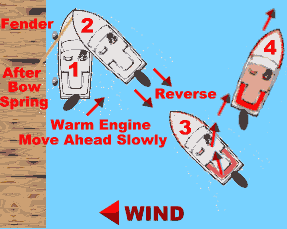
Turn the rudder to angle you away from the dock. Very slowly, shift into forward. You want very little speed here, you’re just giving enough of a boost to push away from the dock against the force of the wind.
Once your stern has angled far enough away from the dock, cast off that spring line. You can now reverse away from the dock fully. Be sure to keep aware of any other boaters or obstacles as you do this.
Shift to forward and idle away from the dock once you are safely clear. Now you can stow lines and the fenders somewhere safely out of the way to avoid a tripping hazard. Keep your speed in check and be observant.
Categories: nauticalknowhow
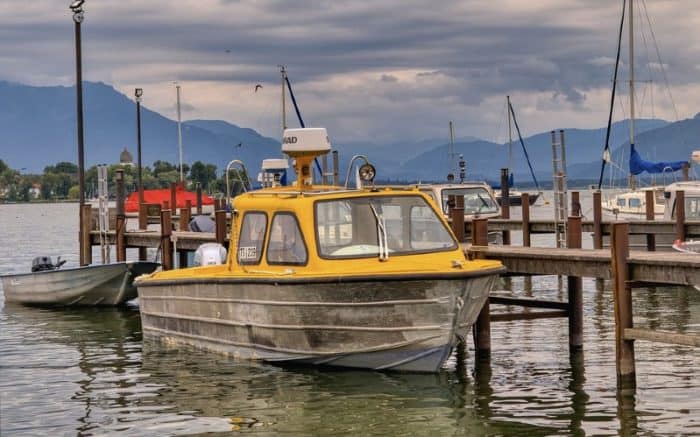
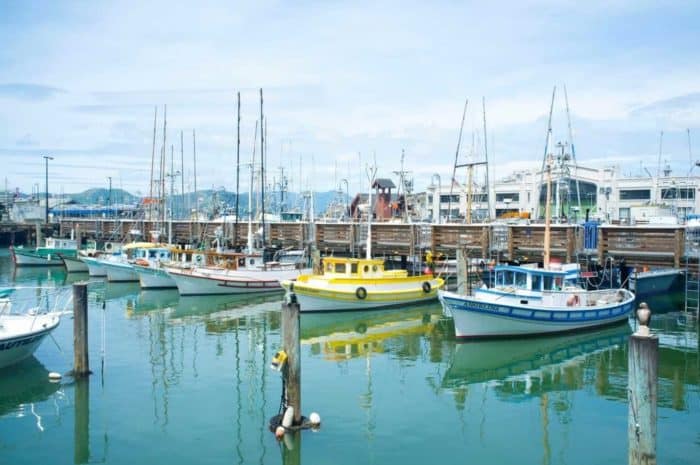
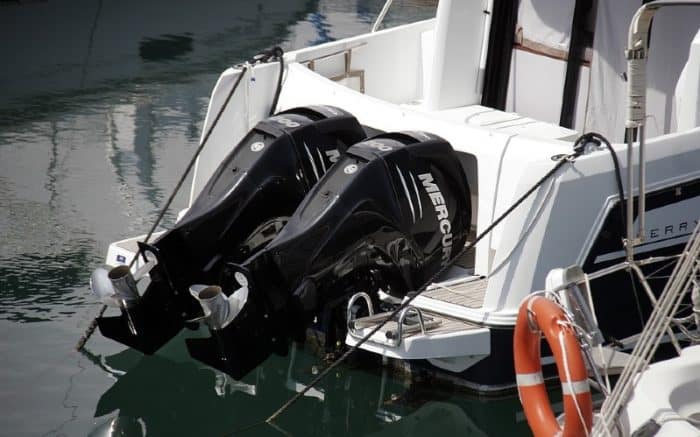
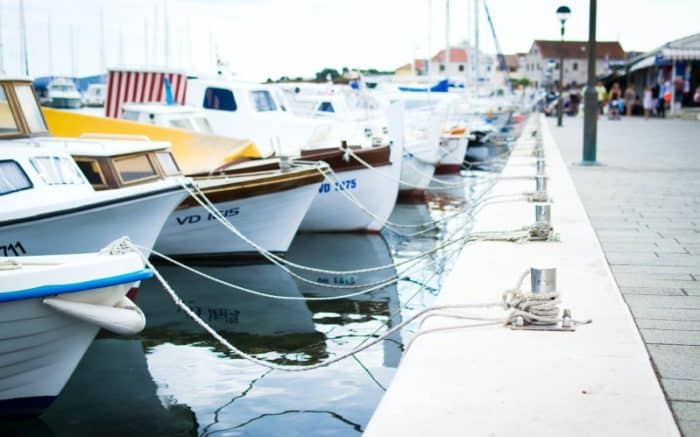












7 Comments
scott williams on August 25, 2019
In the middle graphic (with the ‘After Bow Spring’ labelled), I am wondering how to best run that spring line so it can be released and retrieved from the boat, I guess if the line was tied at both ends on the boat, and simply looped over the dock cleat, a crew member could hope to flip the line off the cleat. But if the boat has backed up enough to tighten that line, flipping may not work. Then the crew member would need to scramble to untie one end of the loop, then pull the line around the cleat and back to the boat (and hope it doesn’t snag).
Definitely helpful if others on the dock would help with lifting the loop off the cleat. Apparently there are fancy knots where a line back to the boat could be yanked to release a knot at the cleat?
Bryan on April 15, 2023
Use a little longer line with an eye on one end. Attach the eye to the cleat on the bow of your boat, now loop that line around the cleat on the dock. Now bring the bitter end of the line back to that same cleat on the bow of your boat wrap it or figure 8 it once or twice. You now have your pivot point set maneuver forward as illustrated when you are ready to back out and cast the line drop the bitter end over the side. The line will still be attached to the bow with the eye loop and you can pull the line in it will pull around the cleat with no hang ups because the end is bitter no eye!
Randy Chorvack on October 10, 2019
I really love how you said to give specific directions to your crew so that they know what to do. This will make docking much more efficient and save a lot of tension. If you just assume they know what to do you’re setting yourself up for a lot of frustration.
Robert Hogward on August 10, 2021
Great article. The instructions are quite specific and worth looking into. Got results for the above instructions?
Robert Hogward on January 10, 2022
When you spend a lot of time at the dock, you would notice boaters settling for a makeshift hook. They may opt for a shovel but it’s not ideal for the purpose. It’s still advisable to get a boat hook.
SHARON on September 7, 2022
I am new at docking and backing into a slip. I kept getting critized by my family of not know how to do it. They think I just jump in snd should know automatically. It stresses me out when there yelling at me. Doesn’t this take time and practice to get good at this. I just bought a boat had it 2 days should I know already how to dock it first try? I don’t think so what’s your thoughts. It not as easy as they think never doing it before or in alot of years with a newer bigger boat. Any suggestions would be greatly appreciated. Thank you.
Gary Roe on October 19, 2022
I bought these dock lines of Regatta for a tritoon we have in Florida, and I liked them so much I bought another set when I bought a new boat for our Illinois lake house. It’s the tool that makes docking and mooring easy for me. There are four pieces of rope in one set with a length of 15 feet, 3/8-inch of diameter, and the eyelet situated at the end part which is 12 inches long. The total length is enough to keep my boat in place and avoid slipping.